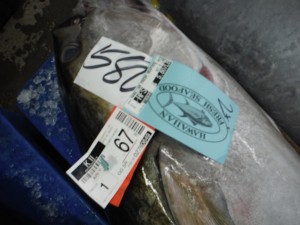…fresh and a little fatty.”
This morning we simultaneously started late and early. Having spent the last week mentally preparing for a 5 am excursion to the Honolulu Fish Auction, a call time of 7 am gave everyone an extra two hours of rest. If the street sweepers didn’t wake you up.
With the image of a traditional auction in my head (“Sold! to the lady in the second row.”) and my sweatshirt to brace against the cold, I was ready for the action. Then the class got an overview of how things work out here. Sean Martin, President of Pacific Ocean Producers (POP), explained how the fish are brought in, processed, and sold. Image shattered.
Ships returning to Honolulu from pelagic long-line fishing ventures typically unload their catches around midnight. Each fish is brought into the warehouse, weighed, identified, given a barcode and color tag (to identify which boat it came from), placed on a wooden palette, and set up in rows to be scrutinized. The fish’s tails are cut to show the quality of the meat based on color, transparency and fat content.

Modeled after Tsukiji Market in Tokyo, fish with the highest market values, in this case the big-eye tuna, are auctioned first. Catches with the lowest market value, mako sharks, are auctioned last. However, not all of one species are auctioned at the same time. All the fish from the first vessel to dock and unload are auctioned. Then the second, then the third. First come, first sold.
The auctioneer takes the fish quality and current market demands for each fish into consideration and sets a starting price per pound for the fish. Depending on season, species and quality, prices may vary from ten cents to twelve dollars. On very special occasions prices have soared near eighteen dollars per pound of tuna.
The auction begins. Non-verbal communication between auctioneer and buyer make the process quick. Four dollars. Three fifty. Three dollars. Three ten. Twenty. Thirty. *rip* Three dollars and thirty cents per pound on a thirty-seven pound fish. The auctioneer has the price written, torn and placed on the fish in half a second. On to the next one.

As the auctioneer moves down the line, the buyers and their assistants put more papers and barcodes on them to indicate which fish now belongs to whom. All the papers are stapled together with the fish, to ensure none disappear during packaging and transport. The moment the fish is wheeled off the floor the auction’s responsibilities are done.
If you’re planning a trip to Honolulu and want to check out the auction, or just have a really strong craving for sushi and think you can eat a whole big-eye tuna fish, here are some quick tips for finding the finest fish:
- Check out those baby blues. There’s a natural ring of blue around the eyes of these creatures. Despite using the best methods available (tons and tons of ice) fish begin to lose this ring once caught. The more blue in the eyes the fresher the fish.
- Look under the hood. Grab the gill and pull upward. These fish have a pink undertone to them so beneath the gills should show a fleshy, peachy shade.
- Pop the trunk. Tail cuts indicate the quality of the fish meat. The lighter, more marbled fish are sought after in Japanese markets while the deeper, leaner fish are desired in New York markets.

Bonus Picture: Guess the Fish!
The weight of this catch sounds like something from a fishing story, but I promise this isn’t a ‘whale tale’.

